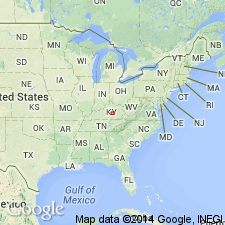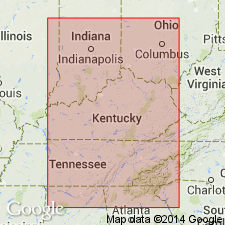
- Usage in publication:
-
- Terrill Member*
- Modifications:
-
- Named
- Dominant lithology:
-
- Mudstone
- AAPG geologic province:
-
- Cincinnati arch
Summary:
Named Terrill Member of Ashlock Formation. "...mainly composed of greenish-gray laminated limy or dolomitic mudstone...Weathered outcrops of mudstone yield abundant small platy fragments. Many bedding surfaces are covered by ripple marks and mud cracks. The basal few feet ...is a limy silty mudstone lacking distinct bedding. The member contains few megafossils. Bryozoans and brachiopods occur sparsely in the basal mudstone...Member ranges from about 5 to 15 feet in thickness...". Underlain by Stingy Creek Member; overlain by Reba Member.
Source: GNU records (USGS DDS-6; Reston GNULEX).

- Usage in publication:
-
- Terrill Member*
- Modifications:
-
- Overview
- AAPG geologic province:
-
- Cincinnati arch
Summary:
The Terrill Member of the Ashlock Formation in south-central KY consists of greenish-gray, laminated, limy or dolomitic mudstone with ripple marks and mudcracks. Common fossils include brachiopods and bryozoans. Thickness is 5 to 15 feet. Overlies the Gilbert Member and underlies the Reba Member, both of the Ashlock Formation. The environment of deposition is interpreted to be tidal flat.
Source: GNU records (USGS DDS-6; Reston GNULEX).
For more information, please contact Nancy Stamm, Geologic Names Committee Secretary.
Asterisk (*) indicates published by U.S. Geological Survey authors.
"No current usage" (†) implies that a name has been abandoned or has fallen into disuse. Former usage and, if known, replacement name given in parentheses ( ).
Slash (/) indicates name conflicts with nomenclatural guidelines (CSN, 1933; ACSN, 1961, 1970; NACSN, 1983, 2005, 2021). May be explained within brackets ([ ]).

